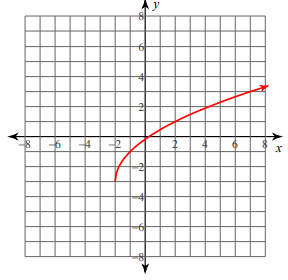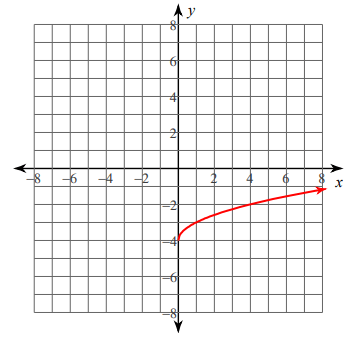GRAPHING SQUARE ROOT FUNCTIONS EXAMPLES
The radical function in the form y = a√(x - h) + k can be graphed easily by comparing with the graph of parent function y = √x
Before start drawing the graph of square root function, it is must to discuss about domain and range of the function.
Set of all possible inputs is called domain of a particular function.
Square root function which is in the form of
y = √x
- the function will be defined only for positive values.
- for the value 0 also it is defined.
- for negative values it is undefined.
- So, domain is x ≥ 0
Set of possible outputs is called range of the function. For the function above,
- range is all positive values including 0.
- So, range is y ≥ 0
The situation to use the concept of transformation :
y = a √(x - h) + k
- If h > 0, then move the graph right h units.
- If h < 0, then move the graph left h units.
- If k > 0, then move the graph up k units.
- If k < 0, then move the graph down k units.
- If sign of a is negative, reflection is done.
Problem 1 :
f(x) = 2√(x + 2) - 3
Solution :
Finding domain :
√(x + 2) ≥ 0
Taking square on both sides.
x + 2 ≥ 0
Subtract 2 on both sides
x ≥ -2
Finding range :
here k = -3, move the graph 3 units down and there is no reflection.
f(x) ≥ -3
So, the range is [-3, ∞)
Transformation :
- Here h = -2, move the graph 2 units left.
- k = -3, move the graph 3 units down.
- a = 2, horizontal stretch of 2 units

Problem 2 :
f(x) = √(x - 3)
Solution :
Finding domain :
√(x - 3) ≥ 0
Taking square on both sides.
x - 3 ≥ 0
Add 3 on both sides.
x ≥ 3
So, the domain is (3, ∞)
Finding range :
here k = 0, then don't have to move the graph from origin. The curve should start from 0 and move upto ∞.
f(x) ≥ 0
So, the range is [0, ∞)
Transformation :
- Here h = 3, move the graph 2 units right.
- k = 0, don't have to move the graph from origin.
- a = 1, no horizontal stretch or compression.

Problem 3 :
f(x) = 3√(x - 4)
Solution :
Finding domain :
√(x - 4) ≥ 0
Taking square on both sides.
x - 4 ≥ 0
Add 4 on both sides.
x ≥ 4
So, the domain is (4, ∞)
Finding range :
here k = 0, then don't have to move the graph from origin. The curve should start from 0 and move upto ∞.
f(x) ≥ 0
So, the range is [0, ∞)
Transformation :
- Here h = 4, move the graph 4 units right.
- k = 0, don't have to move the graph from origin.
- a = 3, horizontal stretch of 3 units.

Problem 4 :
f(x) = √x - 4
Solution :
Finding domain :
√x ≥ 0
Taking square on both sides.
x ≥ 0
So, the domain is (0, ∞)
Finding range :
here k = -4, move the graph 4 units down.
f(x) ≥ -4
So, the range is [-4, ∞)
Transformation :
- Here h = 0, don't have to move the graph from origin.
- k = -4, move the graph down 4 units.
- a = 1, no horizontal stretch or compression.

Problem 5 :
f(x) = -√(3x - 5) + 5
Solution :
Finding domain :
√(3x - 5) ≥ 0
Taking square on both sides.
3x - 5 ≥ 0
Add 5 on both sides and then divide by 3
x ≥ 5/3
So, the domain is [5/3, ∞)
Finding range :
here k = 5, move the graph 5 units up
a = -1, there is a reflection
f(x) ≥ 5
So, the range is (-∞, 5]

Problem 6 :
Solution :
Finding domain :
√(x + 4) ≥ 0
Taking square on both sides.
x + 4 ≥ 0
Subtract 4 on both sides.
x ≥ -4
So, the domain is [-4, ∞)
Finding range :
here k = -1, move the graph 1 units down.
a = 1/2, there is horizontal compression of 1/2 units and there is no reflection.
f(x) ≥ -1
So, the range is [-1, ∞)

Recent Articles
-
Finding Range of Values Inequality Problems
May 21, 24 08:51 PM
Finding Range of Values Inequality Problems -
Solving Two Step Inequality Word Problems
May 21, 24 08:51 AM
Solving Two Step Inequality Word Problems -
Exponential Function Context and Data Modeling
May 20, 24 10:45 PM
Exponential Function Context and Data Modeling